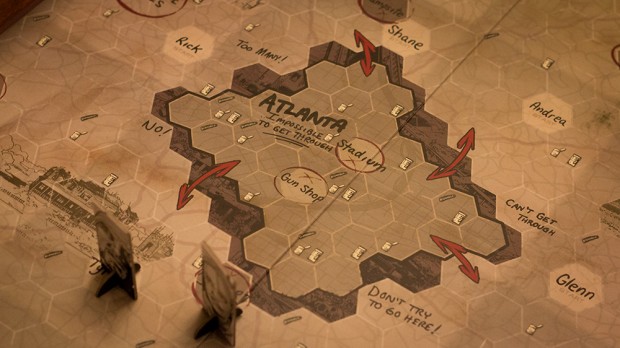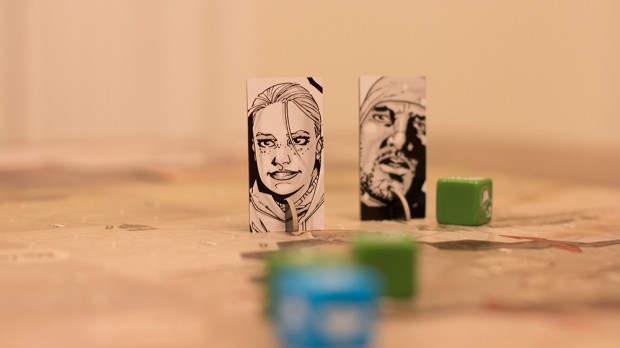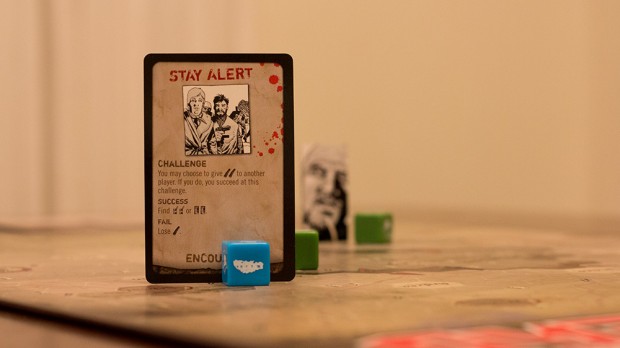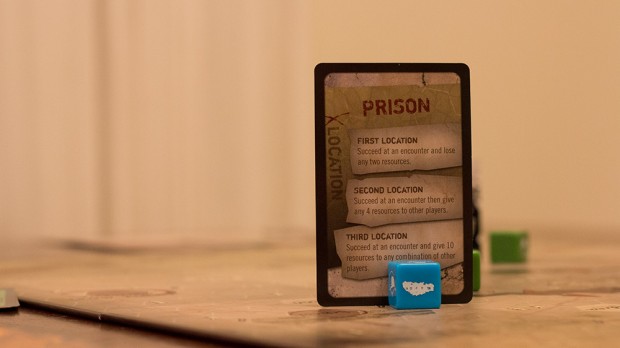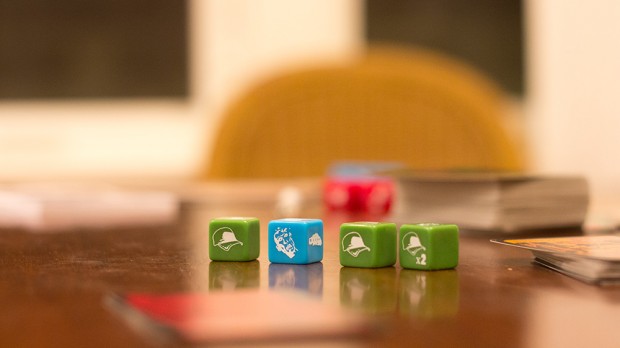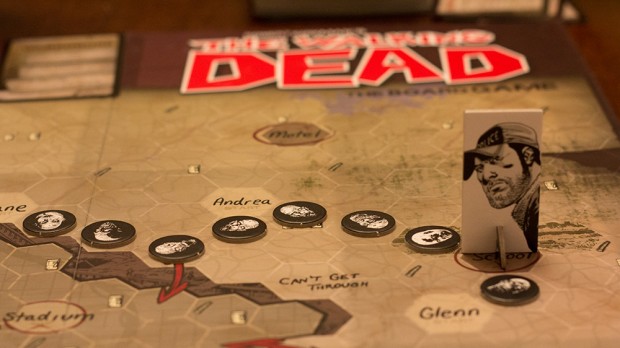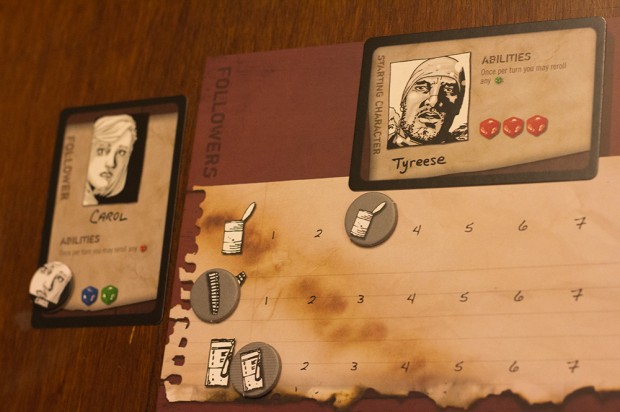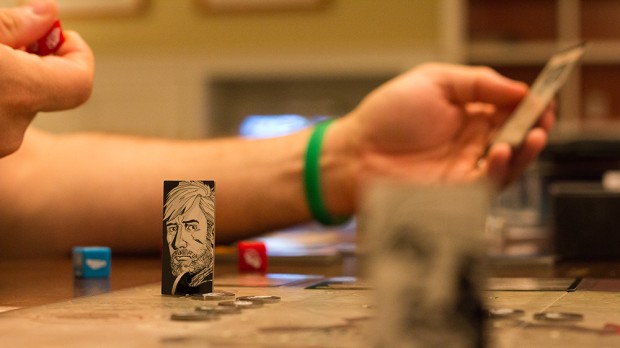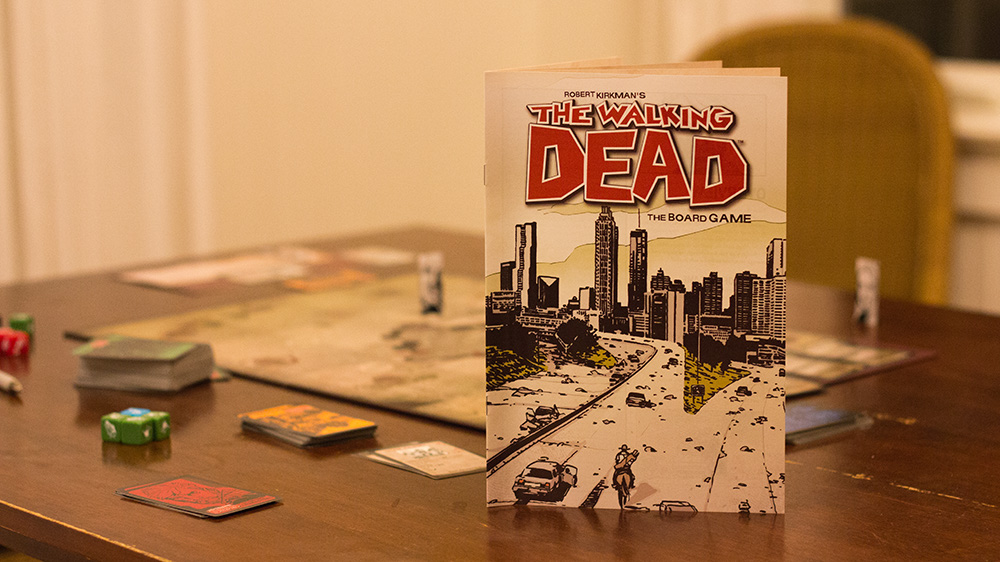

Family trips are great things. You get to spend time with people you might not see very often, and usually you get to go somewhere nice and fun. When some of those days are filled with nothing but rain, however, you get a chance to play board games. This is how I came to play The Walking Dead: The Board Game, a board game based off a comic that spawned a TV show.
If you have never caught an episode of The Walking Dead or read any of the comics (you should do both), the story is one of the zombie variety, and although the basic plot isn’t highly original (survive zombies!), the writing and execution of both mediums are pretty great. For the board game, the “survive zombies” premise is used as a secondary goal to finding a safe place to camp. To win the game, you need to scout three locations in and around Atlanta that you have heard are safe. The first person to scout three wins, and, I guess, after that zombies just don’t bother you ever again.
Set-up
The board is payed out with a grid of hexes over a “map” of the surrounding area of Atlanta that have various locations and starting positions for players to begin. Atlanta resides in the center of the board (with only four ways in because of those pesky zombies), and has a couple of locations for scouting. On many hexes around the board, icons for ammo, gas, and food show up – resources that come in to play during the game.
Four decks of cards – Characters, Followers, Locations, and Encounters – are pulled and shuffled, and to start, players pick a Character card and place its corresponding token on their spot on the board. Every player is then given one random follower and personal location to scout, and three public location cards are placed on the board that everyone can fight over.
Aesthetically, the game looks very nice with plenty of illustrations on the cards. The board is heavy, and simply feels expensive. It folds out in big, thick sections, and is smooth to the touch. It’s a nice board.
Gameplay
The average movement for a character involves moving up to three spaces and either scavenging for resources or scouting a location. If your character runs over a space that has resource icons on it, your movement automatically ends, and you are forced to resolve an encounter. If the space has more than one resource listed, you complete as many encounters as there are icons.
Encounters can range from simple yes/no win scenarios to some luck with dice rolls. After landing of a resource space, you pull one encounter card and resolve what is printed. A success generally nets you something good, from more resources to additional followers. Failures do just the opposite, and the possibility of losing a follower is ever apparent (if this happens, you leave the follower on that space, and another player can come and pick them up).
When scouting a location, depending on what the card says, you will end up doing an encounter or two. The location cards themselves have three increasingly harder objectives on them. On your first scouting mission, you do the first thing listed, the second time you do the second, and so on. When you successfully scout a location, you pick up that card and place it near you to mark that achievement. This also makes it so you don’t turn around and scout the same location three times. At the start of the game, you are giving a personal, secret location to scout, and once you do you don’t get any more, forcing everyone to start fighting over the public pool of locations.
A lot of the time, the encounters you face simply measure your resources against a number, but if you have to roll the dice, it’s because the card says you need to do some actions or fight some zombies.
Hats and zombie killin’
Three different colors (red, green, blue) of dice come with the game, and they correspond to different characteristics of the heroes and followers. On the dice are three images: a zombie face, hat, and RV, and depending on th color, there are more or less of these. Red dice are more of the attack variety and have more zombie faces on the die, green dice is for people who scavenge and have more hats (which equal “actions”), and blue dice have a good mixture of all three. The RV is a wild card and can be anything.
On the hero and follower cards, a mixture of dice is shown that tells you which dice to roll during an encounter. Say the encounter says you need to kill three zombies, you roll your collective dice pool (from your heroes and followers) and if you get three or more zombie faces to come up, you pass. It’s the same for actions.
Fighting happens beyond just the encounter cards, too. The game comes with a couple hundred zombie tokens, and because your heroes have the heaviest and loudest feet imaginable, every time you move from one space to another you place a zombie token on the space you just left as they are alerted to your last presence. This “snail trail” remains on the board, and if another player needs to cross it, he or she has to fight some zombies. On the underside of the zombie token is a number that represents how many are in the horde for that spot. The hordes can go up above ten zombies, so crossing a zombie trail can turn bad quick.
Health, resources, and THE BLACK DIE
Your resource card comes in to play during all of this fighting and action doing. The three resources – food, gas, and ammo – can be used to alter the outcomes of a fight or even make fighting nonexistent. The card itself is basically just a track so you can keep tabs on how many of a resource you have at any given time. At the start of the game, you are given one of each.
Food is used to simply heal your team at the start of every turn. If you are overrun by zombies (by not rolling enough zombie faces, say) then you place damage tokens on your team for however many zombies your don’t slay. If a teammate takes three damage without healing, then he dies and everyone laughs at you. (You can at this point pull another character and start over if you so choose.)
Gas allows you to basically skip over one space. For normal movement, this isn’t necessary, but gas allows you to skip right over a space that has a zombie in it. Isn’t that handy?
Of the three resources, ammo is the one that might actually come back to bite you in the butt. It is tied directly to the black die – a special dice that has the ability to kill tons of zombies. During an encounter or while crossing a zombie trail, you can opt to use one of your ammo to add the black die into the roll. On its faces are three zombie heads with multipliers (x1, x2, x3) which tell you how many extra zombies you kill. On the other three faces are printed the word BLAM! with multipliers as well. The black dice with always result in killing at least one additional zombie, but if it lands on a BLAM!, the resulting noise will alert surrounding zombies, and every space around you will fill up with zombie tokens, making your next move that much harder. The black die is a risky thing, but it certainly helps when dealing with multiple zombies.
Verdict
I happened to only get to play one full game of The Walking Dead, but what I did play was pretty fun. We only had three people playing at the time, and it made for a relatively short game. The problem with our game came from the fact that we didn’t need to travel much to get to any of the locations to scout. This seemed to be just the luck of the draw, and the result was that very few resources were needed for the game. Our people never were in any trouble of dying, and no one really had to cross anyone else’s “snail trail” of zombies. Had we a full game (six people), the pressure would surely amplify and with it, the fun.
I don’t know if the game would stand up by itself as well if you don’t know the subject matter. Two of us who played in my game were familiar with the story so that certainly helped, but unlike the Game of Thrones board game or the Battlestar Galactica board game, I don’t know if there are enough unique elements to make the game one you might pull off the shelf if it simply was called Survive Zombies. Still, this assessment is only after one game and not with a full players, so take that as you will. I wholly believe that I would probably be a bit more positive had I more time with the game and more players.
There is actually a single player version of the game you can play, and a version that allows you to team up with other people, but I did not have a chance to try either of those.
The Walking Dead: The Board Game can be found for $29 at Amazon. For 1-6 players.
